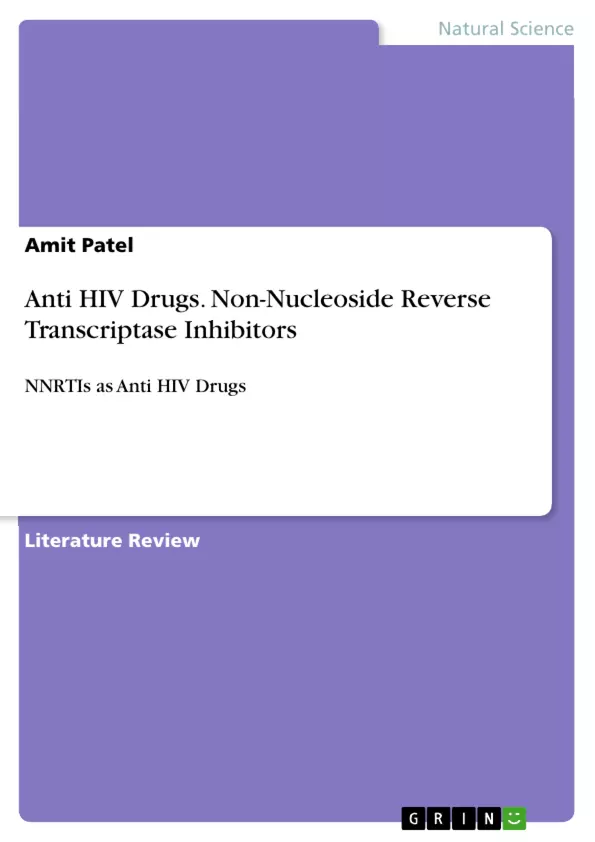The proposed book entitled, “Anti HIV Drugs: Non-Nucleoside Reverse Transcriptase Inhibitors” gives an outline of the Non-Nucleoside Reverse Transcriptase Inhibitors (NNRTI) class of Anti HIV drugs, from the initial discovery of the class in 1990 to the current compounds in clinical development, i.e. around 20 years of research and development efforts. It describes the characteristics of the NNRTIs, their mechanisms of action, HIV resistance to the inhibitors, and the drugs that have been approved for the treatment of HIV infection, that are currently in clinical development. The role of NNRTIs in prevention of HIV transmission is also addressed. The book also covers some basic information about HIV, AIDS and HIV life cycle.
Table of Contents
- Preface
- Acknowledgements
- Chapter-1: History
- Chapter 2: HIV Virus
- 2.1 Structure of HIV
- 2.2 HIV Life Cycle
- 2.2.1 Entry or Binding and Fusion
- 2.2.2 Reverse Transcription (RT)
- 2.2.3 Integration (IN)
- 2.2.4 Transcription
- 2.2.5 Assembly
- 2.2.6 Budding
- 2.2.7 Maturation
- Chapter 3: Anti HIV Drugs
- 3.1 Classification of Anti HIV Drugs
- 3.1.1 Entry Inhibitors
- 3.1.2 Integrase Inhibitors
- 3.1.3 Nucleoside (NRTI) and Nucleotide (NtRTIs) Reverse Transcriptase Inhibitors
- 3.1.4 Non-Nucleoside Reverse Transcriptase Inhibitors (NNRTIs)
- 3.1.5 Protease Inhibitors (PIs)
- 3.2 FDA approved Anti HIV Drugs
- 3.1 Classification of Anti HIV Drugs
- Chapter 4: Non-Nucleoside Reverse Transcriptase Inhibitors
- 4.1 HIV Reverse Transcriptase (RT) enzyme
- 4.2 Mechanism of action of NNRTIs
- Chapter- 5: Important classes of Non-Nucleoside Reverse Transcriptase Inhibitors (NNRTIs)
- 5.1 TIBO {4,5,6,7-Tetrahydro-5-methylimidazo[4,5,1-jk][1,4]benzodiazepine-2(1H)-ones} derivatives
- 5.2 HEPT {1-[(2-hydroxyethoxy) methyl]-6-(phenylthio) thymine}
- 5.3 Pyridinones
- 5.4 Thiocarboxanilide derivatives
- 5.5 DABO {Dihydroalkoxybenzyloxopyrimidine}
- 5.6 DATA {Diaryl triazine}
- 5.7 DAPYS {Diarylpyrimidines}
- 5.8 PBOS {Pyrrolobenzoxazepinones}
- 5.9 Benzoxazinones
- 5.10 2- Amino pyrimidine
- 5.11 Benzophenone
- 5.12 a-Anilinophenylacetamides (a-APAs)
- 5.13 Dipyridodiazepinones
Objectives and Key Themes
This book provides a comprehensive overview of the Non-Nucleoside Reverse Transcriptase Inhibitors (NNRTIs) class of anti-HIV drugs, covering their discovery, development, characteristics, mechanisms of action, resistance, and clinical applications. It also explores the role of NNRTIs in HIV transmission prevention and offers basic information about HIV, AIDS, and the HIV life cycle.- The History and Discovery of NNRTIs
- The Mechanism of Action of NNRTIs
- HIV Resistance to NNRTIs
- The Role of NNRTIs in HIV Treatment and Prevention
- Important Classes of NNRTIs
Chapter Summaries
- Chapter-1: History: This chapter traces the development of NNRTIs, starting with their initial discovery in 1990 and covering the research and development efforts over the past 20 years. It highlights key milestones in the field, leading up to the current state of NNRTI research.
- Chapter 2: HIV Virus: This chapter provides a detailed overview of the HIV virus, encompassing its structure and life cycle. It delves into the various stages of the HIV life cycle, including entry, reverse transcription, integration, transcription, assembly, budding, and maturation. This information provides a fundamental understanding of the virus's behavior and how NNRTIs interact with it.
- Chapter 3: Anti HIV Drugs: This chapter categorizes the various classes of anti-HIV drugs, discussing their mechanisms of action and clinical applications. It specifically focuses on NNRTIs as a class of anti-HIV drugs and explores the development and FDA approval of these medications. This chapter sets the stage for the more in-depth analysis of NNRTIs presented in the subsequent chapters.
- Chapter 4: Non-Nucleoside Reverse Transcriptase Inhibitors: This chapter delves into the specifics of NNRTIs, examining the HIV reverse transcriptase (RT) enzyme and the mechanism of action of these inhibitors. It highlights how NNRTIs bind to the HIV RT enzyme and inhibit its function, ultimately preventing the replication of the virus.
- Chapter- 5: Important classes of Non-Nucleoside Reverse Transcriptase Inhibitors (NNRTIs): This chapter explores different classes of NNRTIs, providing a comprehensive overview of their chemical structures and characteristics. It delves into the various derivatives and subcategories within the NNRTI family, offering a detailed understanding of the diversity and complexity of this class of anti-HIV drugs.
Keywords
This book focuses on the development, characteristics, mechanisms of action, and clinical applications of Non-Nucleoside Reverse Transcriptase Inhibitors (NNRTIs) for the treatment of HIV infection. The core themes include HIV, AIDS, antiretroviral therapy, drug resistance, viral replication, reverse transcriptase enzyme, and the different chemical classes of NNRTIs.- Quote paper
- Amit Patel (Author), 2014, Anti HIV Drugs. Non-Nucleoside Reverse Transcriptase Inhibitors, Munich, GRIN Verlag, https://www.hausarbeiten.de/document/283092


